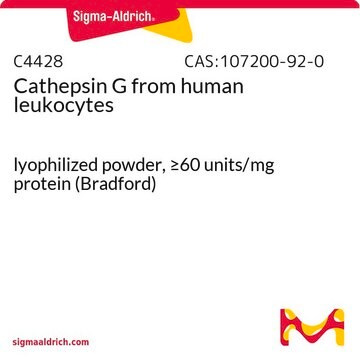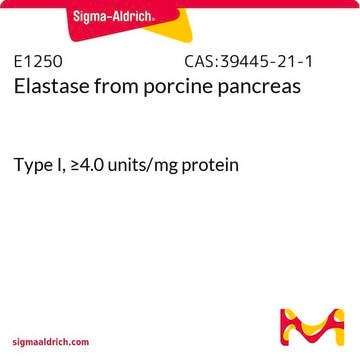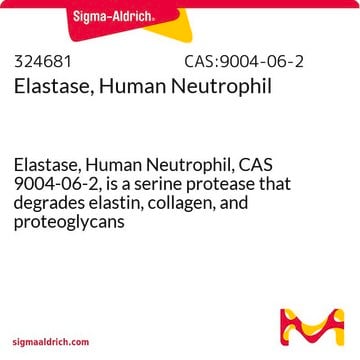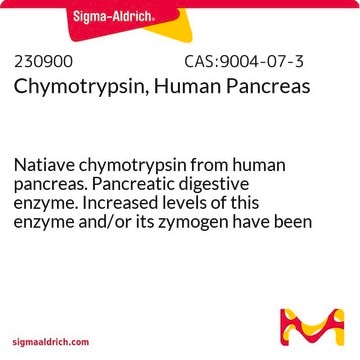Lot-specific information can be found on the certificate of analysis (COA). For example, for lot #: 3952706, the specific activity is 3.0 U/mgP, and the pack size is 100 milliunits, which is equivalent to 0.1 units. Therefore, for this specific lot, there is 0.033 mg of protein. In general, for this material, each mg is about 2 to 4 units, so 100 milliunits or 0.1 unit is equivalent to about 0.025 to 0.05 mg amount of protein.
219373
Cathepsin G, Human Neutrophil
Cathepsin G, Human Neutrophil, CAS 107200-92-0, is a purified native cathepsin G. Acts as a potent agonist of human platelet activation leading to their aggregation.
Sinonimo/i:
Cathepsin G, Human Neutrophil
Scegli un formato
Scegli un formato
About This Item
Prodotti consigliati
Origine biologica
human neutrophils
Livello qualitativo
Descrizione
Merck USA index - 14, 1905
Saggio
≥95% (SDS-PAGE)
Stato
lyophilized solid (Salt-free)
Attività specifica
≥2 units/mg protein
Produttore/marchio commerciale
Calbiochem®
Condizioni di stoccaggio
OK to freeze
tecniche
inhibition assay: suitable
Compatibilità
suitable for molecular biology
applicazioni
life science and biopharma
Condizioni di spedizione
ambient
Temperatura di conservazione
−20°C
Informazioni sul gene
human ... CTSG(1511)
Descrizione generale
Cathepsin G is stored in its active form in azurophil granules of neutrophils or monocytes. Its mature form contains one potential glycan-binding site and three disulfide bonds.[1]
Applicazioni
Azioni biochim/fisiol
Attenzione
Definizione di unità
Nota sulla preparazione
Reconstitute in 150 mM NaCl, 50 mM sodium acetate buffer, pH 5.5.
Ricostituzione
Altre note
Shamamian, P., et al. 2001. J. Cell Physiol.189, 197.
Groutas, W.C., et al. 1993. Biochem. Biophys. Res. Commun.197, 730.
Stone, P.J., et al. 1993. Biochem. Biophys. Res. Commun.197, 130.
Groutas, W.C., et al. 1992. Arch. Biochem. Biophys.294, 144.
Maison, C.M., et al. 1991. J. Immunol.147, 921.
Travis, J. 1988. Am. J. Med.84, 37.
Note legali
Codice della classe di stoccaggio
11 - Combustible Solids
Classe di pericolosità dell'acqua (WGK)
WGK 3
Punto d’infiammabilità (°F)
Not applicable
Punto d’infiammabilità (°C)
Not applicable
Certificati d'analisi (COA)
Cerca il Certificati d'analisi (COA) digitando il numero di lotto/batch corrispondente. I numeri di lotto o di batch sono stampati sull'etichetta dei prodotti dopo la parola ‘Lotto’ o ‘Batch’.
Possiedi già questo prodotto?
I documenti relativi ai prodotti acquistati recentemente sono disponibili nell’Archivio dei documenti.
-
Could you please provide the item number for R: 219373? I recently purchased Human Neutrophil Cathepsin G (219373) with a concentration of 100MIU. I'm experiencing difficulty converting it to µg/ml for the required dilution. Can you assist me with this? Thank you.
1 risposta-
Utile?
-
Filtri attivi
Il team dei nostri ricercatori vanta grande esperienza in tutte le aree della ricerca quali Life Science, scienza dei materiali, sintesi chimica, cromatografia, discipline analitiche, ecc..
Contatta l'Assistenza Tecnica.







